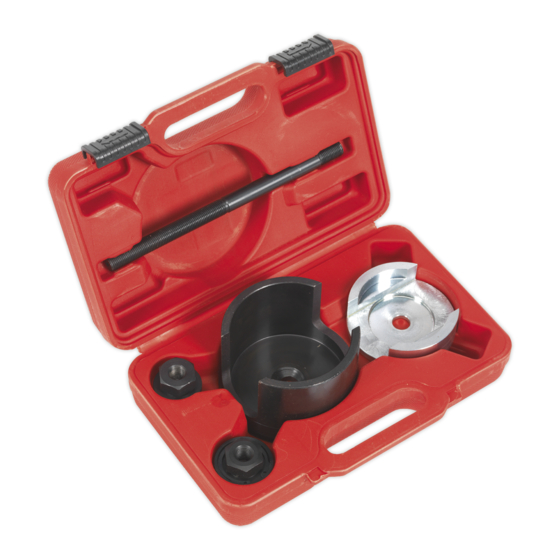
Advertisement
Quick Links
Thank you for purchasing a Sealey product. Manufactured to a high standard this product will, if used according to these instructions
and properly maintained, give you years of trouble free performance.
IMPORTANT: PLEASE READ THESE INSTRUCTIONS CAREFULLY. NOTE THE SAFE OPERATIONAL REQUIREMENTS, WARNINGS AND CAUTIONS.
USE THE PRODUCT CORRECTLY AND WITH CARE FOR THE PURPOSE FOR WHICH IT IS INTENDED. FAILURE TO DO SO MAY CAUSE
DAMAGE AND/OR PERSONAL INJURY, AND WILL INVALIDATE THE WARRANTY. PLEASE KEEP INSTRUCTIONS SAFE FOR FUTURE USE.
1. SAFETY INSTRUCTIONS
WARNING! ensure health and safety, local authority and general
workshop practice regulations are adhered to when using tools.
DO NOT use tools if damaged.
DO NOT use tool for purposes other than for which it is
designed.
DO NOT use tool when you are tired or under the influence of
alcohol, drugs or intoxicating medicines.
Maintain tools in good and clean condition for best and safest
performance.
Ensure that a vehicle which has been jacked up is adequately
supported with axle stands and that the wheels are chocked,
refer to the vehicle manufacturer's service instructions, or a
proprietary manual.
Ensure that work area has adequate lighting.
Keep children and unauthorised persons away from the work
area.
Wear approved eye protection. A full range of personal safety
equipment is available from your Sealey dealer.
Wear suitable clothing to avoid snagging. Do not wear jewellery
and tie back long hair.
DO NOT use air tools to operate the force screw.
When not in use, store tool in a safe, dry childproof area.
IMPORTANT: The force screw must be kept well lubricated.
WARNING! Failure to comply with these instructions may
result in damage to the tool or vehicle and/or personal injury.
WARNING! The warnings, cautions and instructions
referred to in this manual cannot cover all possible
conditions and situations that may occur. It must be
understood that common sense and caution are factors
which cannot be built into this product, but must be applied
by the operator.
IMPORTANT: This manual is provided as a guide only, refer to
the vehicle manufacturer's service instructions, or a proprietary
manual, to establish the current procedure and data.
2. INTRODUCTION & APPLICATION
2.1
Introduction: Remove/Install front mounting bushes in Laguna
rear sub-frame. Can be used in situ – no need to remove
subframe from vehicle.
Applications: Renault Laguna, 2001 onwards.
ITEM
PART NO:
1
VSE4777.V2.01
2
VSE4777.V2.02
3
VSE4777.V2.03
4
VSE4777.V2.04
5
VSE4777.V2.05
Fig.1
DESCRIPTION
FORCE SCREW
FLANGE NUT
FORCE NUT ASSEMBLY
COMPRESSOR SLEEVE
BRIDGE PIECE
Original Language Version
INSTRUCTIONS FOR:
BUSH REMOVAL TOOL
(RENAULT LAGUNA)
VSE4777.V2
MODEL No:
3. OPERATION
DO NOT use air tOOLs tO Operate the fOrce screw.
3.1 Ensure that the vehicle is adequately supported on axle stands
before working under the vehicle.
3.2 Although there is no need to remove the subframe from the vehicle
it will be necessary to lower it to gain access to both sides of the
bush housing.
3.3 Remove the rear wheels, the brake pipe retaining plate, the left
and right-hand bush retaining brackets and the lower shock
absorber bolts. For a detailed and up to date breakdown of this
procedure refer to the vehicle manufacturer's service
instructions, or a proprietary manual.
3.4 To remove the old bush assemble the tool onto the bush and
sub-frame as shown in Fig.2. Ensure that the force screw 1 is well
lubricated prior to assembly. Hold the flange nut 2 with a 24mm
ring spanner. Using a ratchet wrench with a 24mm deep socket
turn the nut on the force nut assembly 3 clockwise to drive the
bush out of its housing. The bush will extract easier if penetrating
oil has been applied to the bush housing prior to removal.
3.5 To insert the new bush, assemble the tool and bush onto the
sub-frame as shown in Fig.3. Ensure that the force screw 1 is well
lubricated prior to assembly. Hold the flange nut 2 with a 24mm
ring spanner. Using a ratchet wrench with a 24mm deep socket
turn the nut on the force nut assembly 3 clockwise to drive the
bush into the compressor sleeve 4.
Fig.2
Fig.3
VSE4777.V2
Issue: 1 - 03/01/12
Advertisement

Summary of Contents for Sealey VSE4777.V2
- Page 1 VSE4777.V2 MODEL No: Thank you for purchasing a Sealey product. Manufactured to a high standard this product will, if used according to these instructions and properly maintained, give you years of trouble free performance. IMPORTANT: PLEASE READ THESE INSTRUCTIONS CAREFULLY. NOTE THE SAFE OPERATIONAL REQUIREMENTS, WARNINGS AND CAUTIONS.
- Page 2 WARRANTY: Guarantee is 12 months from purchase date, proof of which will be required for any claim. INFORMATION: For a copy of our latest catalogue and promotions call us on 01284 757525 and leave your full name and address, including postcode. Sole UK Distributor, Sealey Group, www.sealey.co.uk...













